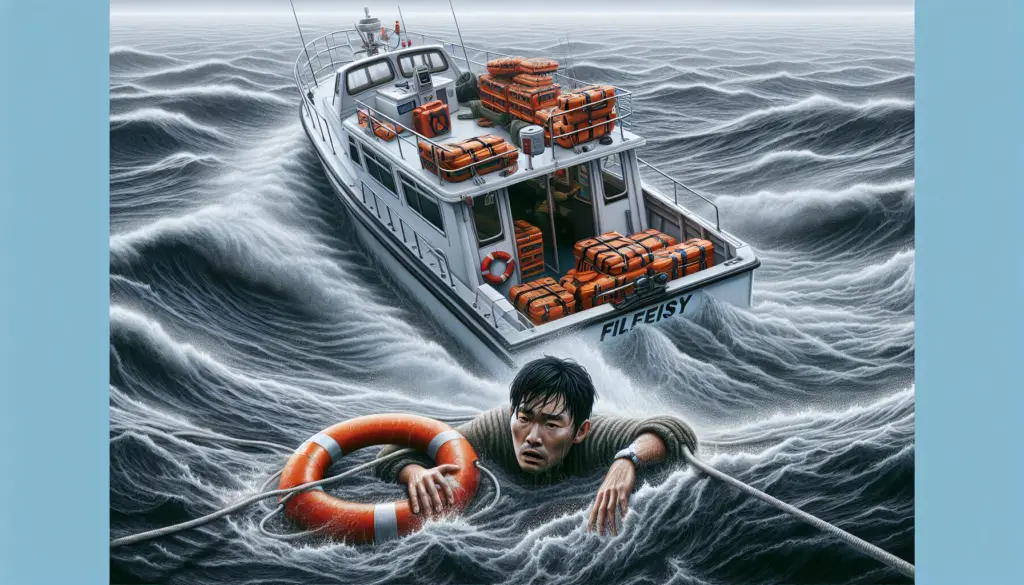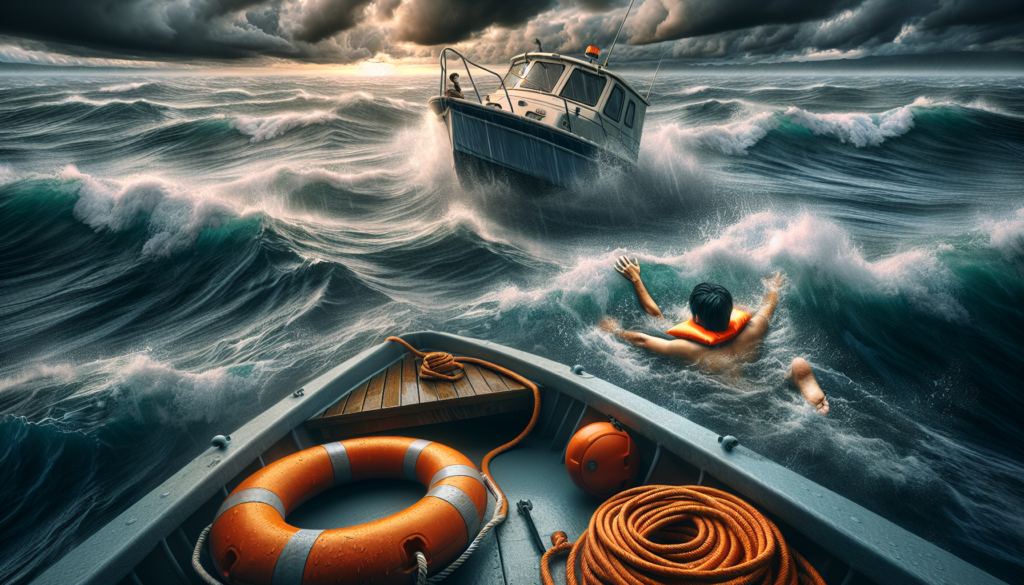Imagine you’re cruising on sapphire waters under a cloudless azure sky when a chilling cry of “Man overboard!” shatters the tranquility. Your heartbeat quickens, frightened yet determined to help. This article imparts crucial knowledge that will guide your actions in such a scenario, from initial shock to methodical response. Learn about proactive measures, immediate rescue techniques, and follow-up procedures to ensure safety. The sea is a beast of beauty and terror, and it’s pivotal that you’re well-armed to face whatever it may cast at you. “What To Do In Case Of A Man Overboard Situation” equips you with the wisdom you’ll need to act swiftly and smartly, potentially saving a life.

Understanding the Importance of Acting Quickly
When an emergency situation unfolds at sea, such as a man overboard scenario, the importance of acting quickly cannot be overstated. Time becomes invaluable, and every second spent might mean the difference between life and death. Whether you are the captain of the ship, part of the crew or even a passenger, your swift and decisive action can save a life.
Recognizing the Immediate Danger
The very first step in this high-adrenaline situation is acknowledging the gravity of the situation. As the vastness of the sea can be mercilessly unforgiving, a man overboard situation is, with every passing second, getting increasingly dangerous. Starting from the risk of drowning or suffering hypothermia, to the possibility of being lost in the open water, the imminent peril is real and palpable.
Staying Calm Under Pressure
As counterintuitive as it may seem during such an emergency, staying calm is an essential aspect of managing the crisis most effectively. Anxiety can cloud judgement, make communication difficult and eventually lead to grave mistakes. Remaining calm not just helps you think clearly and act decisively, but also plays a significant role in keeping the morale of the others up.
Effecting Quick Communication with Crew
Immediate communication to all other crew members is crucial following the realization of the overboard incident. When the clock is ticking and every second counts, conveying the correct information to the right people can make a critical difference. Stay clear, concise and firm in your communication.
Alerting the Crew
Prompt and effective communication also means alerting the whole crew about the emergency at hand. It is essential to notify everyone on board about the situation, to ensure there are no false alarms or confusions.
Announcing Man Overboard
The man overboard announcement is typically a standard part of the emergency procedures of any vessel – be that a portrait or a starboard shout, or a three long blasts on the ship’s horn. This announcement is designed to be unequivocal and immediately recognizable.
Using the Ship’s Alarm Systems
If the vessel is equipped with alarm systems, these should be used without hesitation. These alarms, aside from expressing the urgent nature of the situation, can also serve to provide essential instructions to everyone on the ship.
Assigning Roles to Crew Members
In a man overboard situation, it is best if each crew member has a predefined role to play. Having a clear understanding of their respective responsibilities prevents panic and confusion from setting in and can expedite the entire rescue procedure.

Locating the Overboard Person
One of the toughest parts of a man overboard situation, once the alarm has been activated, is to locate the missing person.
Maintaining Visual Contact
If someone saw the person go overboard, their role becomes crucial. They should continuously point towards the person in the water, helping the crew maintain visual contact for as long as possible.
Utilizing Man Overboard Marker and Buoy
Utilize all the resources you have on board. Deploying a smoke or dye marker, or a man-overboard (MOB) buoy can not only help track the person in the water but also provide potential flotation assistance.
Using Navigation and GPS Tools
Use your ship’s navigation and GPS tools. Modern GPS systems often have a man overboard function that, when activated, notes the exact location of the event.
Manoeuvring the Vessel
A key step in the rescue mission is manoeuvring the vessel.
Deciding on the Suitable Man Overboard Maneuver
The choice of the actual maneuver will greatly depend on the properties of your vessel and the current sea and weather conditions. Make sure to consider all these factors while deciding on the most suitable MOB maneuver.
Maintaining A Safe Speed
While speed is of the essence in this situation, it is equally important to maintain a speed that is safe for all those involved in the operation, including the person in the water.
Positioning the Vessel for Rescue
This involves positioning the vessel upwind or uptide of the person in the water, so it drifts onto them. Perfect positioning will enable the easiest and safest rescue.

Deploying Rescue Equipment
Deploying the right equipment is a critical aspect of the rescue process.
Choosing Suitable Rescue Equipment
The choice of rescue gear will greatly depend on the person in the water’s condition, your ship’s gear, and the prevailing weather and water conditions.
Executing the Deployment of Lifebuoys
Lifebuoys, preferably attached with a buoyant line or a light, should be thrown towards the victim. Aim to get them as close as possible to assist their efforts to stay afloat.
Understanding the Role of Liferaft
Liferafts serve as boarding aids for unconscious victims or when the sea conditions make it impossible to pull the person on board directly.
Initiating the Rescue
The actual rescue operation starts once the victim is located, and the equipment deployed.
Assessing the Consciousness of the Victim
If they are conscious and responsive, they can help themselves to some extent. If they are unconscious, the operation becomes even more challenging.
Pulling the Victim Aboard
Care must be taken, especially when pulling an unconscious person on board. Position them horizontally and avoid vertical hoisting to protect from possible cardiovascular collapse, often known as ‘hydrostatic squeeze’.
Administering Immediate Medical Aid
Immediate medical attention is required, even if the person seems unharmed. Hypothermia, water inhalation, or shock can cause serious problems if not treated promptly.

Contacting the Authorities
As soon as the situation allows, reach out to the coastline authorities.
Notifying the Coast Guard
Get in touch with the Coast Guard. They not only have the best equipment for search and rescue operations but can also provide crucial advice for the rescue process.
Informing the Port Authority
Notify the nearest port authority. They can assist with directing you to the nearest available medical facility and provide support for the docking procedure if your vessel transports the victim to shore.
Relaying Critical Information About The Incident
Make sure you provide all necessary information about the incident, including location, time, weather conditions and the person’s condition.
After the Rescue: Medical Care
The end of the rescue operation is when the medical help starts.
Performing CPR if Necessary
If the victim is unresponsive or doesn’t have a pulse, immediately begin chest compressions and rescue breaths.
Addressing Hypothermia and Other Injuries
Any possible injuries, including the risk of hypothermia, need to be addressed as quickly as possible. Even if you are not trained in first aid, you can provide assistance by providing warmth or helping address visible injuries before professional help arrives.
Arranging for Medical Evacuation if Required
If the person’s condition requires it, and the circumstances permit, try to arrange medical evacuation. Shock or severe hypothermia, for instance, often need immediate professional medical assistance to prevent further complications or even fatalities.
Documenting the Incident
Preparation of Incident Report
It’s important to prepare a comprehensive incident report. Include all relevant details of the event, from the initial fall overboard to the rescue and subsequent medical attention.
Gathering Witness Statements
Gather statements from all crew members who were involved or witnessed the situation. These accounts provide essential perspectives for understanding what happened, why it happened and how precisely it was handled.
Preserving Evidence for Investigation
Don’t move or manipulate possible evidence until it’s been documented thoroughly and correctly. If there need to be any investigations later, preserving evidence is critical.
Post-Incident Procedures
Conducting A Debriefing
Once the rescue operation is over, hold a debrief with everyone involved. Discuss what went well, what could have been better, and how to prevent similar incidents in the future.
Reviewing and Updating Safety Procedures
Use the incident as a learning opportunity to review the vessel’s current safety procedures. Update any outdated methods, and fill any identified gaps in safety training.
Providing Support to The Victim and Crew
Lastly, it is essential to provide appropriate physical and mental support to the victim and the crew members involved in the incident. Traumatic events may have short- and long-term effects, and providing support during these times is vital. Everyone should be encouraged to seek help if needed.
A man overboard scenario is a terrifying emergency that demands quick thinking, and even quicker response. The ability to take immediate action, communicate effectively, utilize all available resources, and follow the emergency procedures in an organized manner, can be the key to saving a life.

